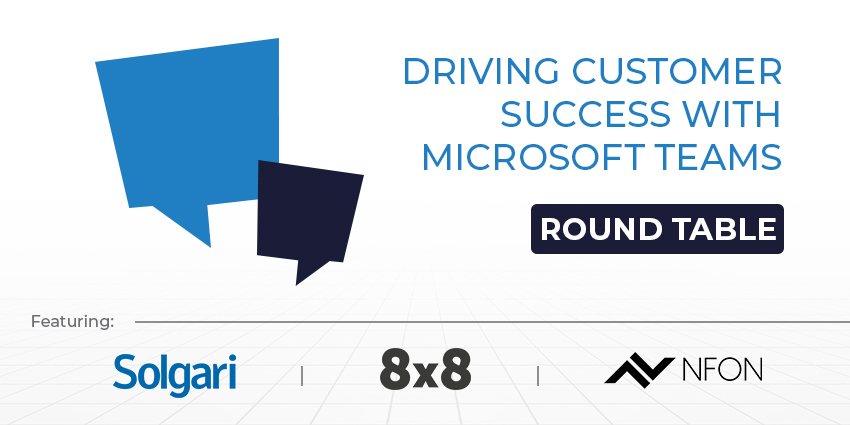Microsoft Teams has become more than just a meeting and chat platform; it is increasingly being leveraged as a tool to unify internal collaboration with customer-facing interactions.
Companies are looking for ways to use Teams not only to streamline workflows but also to enhance customer engagement and satisfaction, creating a seamless experience across both employee and client touchpoints.
And as businesses strive to align digital tools with tangible customer outcomes, the challenge lies in understanding how to measure success beyond adoption rates and usage metrics.
Integrating Teams with CRM systems, analytics platforms, and contact centre solutions is opening new possibilities, allowing firms to capture every interaction, automate routine tasks, and provide richer, more personalised customer experiences.
For our latest UC Round Table topic, “Driving Customer Success with Microsoft Teams”, we spoke with experts and executives from Solgari, NFON and 8×8 about how organisations are using Microsoft Teams to break down internal silos, improve operational efficiency, and deliver measurable improvements in customer satisfaction.
We explored the challenges companies face, the opportunities for AI and Copilot features, and the key metrics organisations should track to ensure success.
How are organisations leveraging Microsoft Teams to go beyond internal collaboration and actually enhance customer engagement and satisfaction?
Organisations are increasingly realising that Microsoft Teams does not need to be confined to internal collaboration. By integrating customer communications – voice, SMS, email, and chat – directly into Teams, companies can create a single workspace where customer interactions are handled alongside internal collaboration. This approach reduces friction, enables faster resolution, and allows employees to bring in the right expertise instantly.
Myles Leach, Managing Director, NFON UK

Leach stresses the importance of combining Teams with enterprise-grade telephony and analytics for external engagement.
“Teams has become the default communication platform for UK businesses. However, while it excels in collaboration, it lacks robust telephony and customer engagement capabilities. Businesses that rely on customer interactions need enterprise-grade telephony alongside Teams’ features. When organisations are using Teams actively for internal collaboration, bringing in external collaboration makes absolute sense. Organisations should think about this just as the starting point, though, as bringing Teams Voice, Recording, Analytics and CRM integration adds a huge amount of value for both employees and customers. This then allows organisations to build out into the world of AI, Copilot and Copilot Agents. Teams and Teams voice is just the starting point for organisations.”
Paul Mason, Chief Commercial Officer, Solgari
Mason highlights that the true value lies in removing the walls between collaboration and customer engagement.
“The shift happens when you stop treating Teams as an internal meeting tool and start routing actual customer conversations through it. We’re seeing organisations integrate voice calls, WhatsApp, SMS, and email directly into Teams, so customer interactions sit alongside the collaboration that’s already happening there. It creates a single workspace where a support agent can take a customer call, pull in a product specialist with one click, and have the entire conversation, context and all, automatically logged to the CRM. The real value isn’t collaboration or customer engagement, it’s removing the wall between them.”
Prateek Ranganathan, Senior Product Manager, 8×8
Ranganathan explains the strategic benefit of treating Teams as a unified communications fabric.
“The most forward-thinking organisations are challenging the artificial barrier between their customer-facing teams and the rest of the organisation, by using Microsoft Teams as more than just an internal tool. The new imperative is an ‘all-hands-on-deck’ customer experience, which requires a unified fabric of communications. This means empowering all knowledge workers with native global voice directly within their Teams client. Simultaneously, it means embedding those same rich communication tools directly into the CRM. When Teams acts as the communications fabric connecting every employee—whether in a CRM or the Teams app—the entire organization is weaponized to serve the customer.”
What are the biggest challenges companies face when aligning Teams deployments with measurable customer success outcomes?
Despite the potential of Teams, organisations often struggle to align deployments with real customer outcomes. Common pitfalls include focusing on IT metrics rather than customer-centric KPIs, trying to force all roles into a single workflow, or failing to define clear success measures before rollout.
Paul Mason, Chief Commercial Officer, Solgari
Mason highlights that success comes from choosing measurable outcomes before implementation.
“Most organizations measure the wrong things – licenses purchased, meetings held, adoption rates. Those are IT metrics, not customer outcomes. The challenge is defining what success actually looks like before you roll anything out: Are you trying to reduce handling time? Improve first-contact resolution? The firms that succeed pick one measurable outcome, track it religiously, and refuse to expand until they’ve proven value. The ones that struggle deploy the technology first and figure out the metrics later, which is backwards.”
Myles Leach, Managing Director, NFON UK
Leach emphasises the importance of understanding Teams’ capabilities and aligning them to specific business needs.
“Businesses don’t always realise what Microsoft Teams is capable of, especially when it comes to features that boost customer satisfaction. This is when they should turn to their local IT reseller to request tutorials and to drill down into what their business needs and how to align it to Microsoft Teams functionality. Whether a small or medium sized business, a reseller partner can help you turn Microsoft Teams into a powerful business phone system and collaboration hub.”

Prateek Ranganathan, Senior Product Manager, 8×8
Ranganathan stresses protecting specialised roles while ensuring seamless integration.
“Rather than forcing all employee personas into a ‘mythical single pane of glass’ within Microsoft Teams, a more effective approach recognises that specialised roles, such as customer service agents, benefit from dedicated workspaces. While empowering knowledge workers within Teams is ideal, protecting customer-facing agents in their own environment allows for higher focus. The key is to ensure both environments are seamlessly integrated with the Teams ecosystem through shared directory, presence, and chat, eliminating silos and maximising the strengths of each platform.”
How can integrations with CRM, analytics, or contact centre platforms help Teams become a true driver of customer success?
Integrations turn Teams from a communication platform into a full customer intelligence engine. By embedding CRM, analytics, and contact centre capabilities, organisations can capture every interaction, provide agents with actionable insights, and automate workflows to improve both efficiency and customer satisfaction.

Paul Mason, Chief Commercial Officer, Solgari
Mason explains that integration transforms Teams into a data-driven customer tool.
“Integration is the difference between Teams as a fancy phone system and Teams as a customer intelligence engine. When every interaction, voice, chat, video, automatically updates your CRM, you’re not just saving admin time, you’re turning conversations into data. That’s when AI actually becomes useful, because it has complete context to work with instead of fragments scattered across five systems. But integration only matters if your people actually use it. We’ve seen gorgeous technical integrations fail because agents still pick up the desk phone out of habit.”
Myles Leach, Managing Director, NFON UK
Leach underscores the value of embedded contact centre features.
“Customer-facing businesses with customer service teams can really benefit from Microsoft Teams integration with Contact Centre as a Service (CCaaS). By embedding contact centre capabilities into Teams, businesses gain advanced call routing to ensure customers reach the right agent; AI-powered analytics for better decision-making and omnichannel support including voice, email, chat and social media.”
Prateek Ranganathan, Senior Product Manager, 8×8
Ranganathan positions Teams as a core part of a best-in-class tech stack.
“The industry has shifted to a ‘composable enterprise,’ where assembling best-in-class solutions is the norm. For Microsoft Teams to be a true driver of customer success, it cannot be an island. A truly effective strategy uses an open communications platform to connect Teams to this composable world. This platform must integrate deeply into key systems of record, like CRMs, embedding communications where users live. It must also serve as the anchor for the specialised agent workspace, connecting it back to the Teams ecosystem. This makes Teams a core, frictionless part of a best-in-class tech stack, rather than just another silo.”
With AI and Copilot features becoming more central to Teams, how do you see these innovations transforming customer experience and service delivery?
AI and Copilot features in Teams are enabling organisations to automate routine tasks, provide real-time insights, and allow employees to focus on complex, high-value interactions. The challenge is balancing efficiency with human empathy to ensure AI augments, rather than replaces, human judgment.
Paul Mason, Chief Commercial Officer, Solgari
Mason explains that AI reduces administrative burden and enhances customer-facing work.
“AI’s biggest impact right now isn’t customer-facing, it’s removing the administrative burden that drowns service teams. Automatic call summaries, CRM updates, sentiment tracking – these save twenty to thirty minutes per agent per day, which means they can handle more customers or spend more time on complex issues. The customer-facing AI like chatbots and virtual agents works when you keep the scope narrow and the escalation path fast. Where organisations get burned is deploying AI that’s confidently wrong, or that traps customers in loops with no human escape route. AI should deflect the routine so humans can handle the complex – not replace judgment.”
Myles Leach, Managing Director, NFON UK
Leach highlights AI-driven productivity for knowledge workers and seamless customer access to data.
“Microsoft uses its own AI features to boost productivity in Teams by automating routine tasks, such as recording decisions and assigning tasks. But with the right integrations, Teams can do much more, such as enable real-time access to customer data during interactions, creating a seamless customer experience.”
Prateek Ranganathan, Senior Product Manager, 8×8
Ranganathan stresses a persona-specific AI approach to preserve human empathy.
“The central tension in AI adoption is between AI efficiency and the human touch. While businesses are rapidly adopting AI, customers still place a high premium on human connection for complex issues. With features like Copilot, Microsoft Teams is becoming the hub for AI-powered general productivity for knowledge workers. However, this same AI isn’t purpose-built for real-time customer service. The right strategy is two-fold: First, leverage Copilot in Teams to augment the knowledge worker. Second, deploy specialised, real-time AI for the agent—like surfacing answers or summarising conversations—which enhances their ability to provide the human empathy customers demand. This ‘Man + Machine’ model, applied appropriately by persona, delivers efficiency and improves the customer experience.”
What key metrics or success indicators should organisations track to understand the real customer impact of their Teams strategy?
Organisations must move beyond adoption and usage statistics, focusing instead on customer-centric metrics. This includes first-contact resolution, average handling time, data completeness, and agent effort scores, which together reflect how effectively Teams supports both employees and customers.
Paul Mason, Chief Commercial Officer, Solgari
Mason underlines measuring outcomes over internal usage.
“First-contact resolution tells you if customers are actually getting helped, not just processed. Average handling time shows whether your workflows are getting faster or just more complicated. But the metric most organizations miss is data completeness, what percentage of customer interactions are being captured and logged automatically. If your CRM is still full of gaps because agents forget to update it, your Teams integration isn’t working no matter what the vendor dashboard says. You can’t improve what you’re not measuring, and you can’t measure what you’re not capturing.”
Myles Leach, Managing Director, NFON UK
Leach outlines external CX and operational metrics to track success.
“Organisations should measure the real customer impact of their Microsoft Teams strategy by tracking outcomes that go beyond adoption metrics. Key indicators include improvements in customer satisfaction (CSAT, NPS) and first contact resolution, reductions in average handle and resolution times, and increases in collaboration efficiency between departments. They should also assess operational gains such as faster internal response times, higher engagement with integrated systems like CRM or CCaaS, and better utilisation of AI tools for customer support. Finally, success is reflected in employee experience metrics — including satisfaction, digital dexterity, and productivity — which together show how effectively Teams enhances both internal collaboration and external customer experience.”
Prateek Ranganathan, Senior Product Manager, 8×8
Ranganathan emphasises agent-centric metrics to lower customer effort.
“Many organizations mistakenly focus on internal Microsoft Teams metrics like adoption rates or call volume. To measure real customer impact, the focus must shift to external CX metrics. The most critical indicator is First Contact Resolution (FCR). Is your Teams strategy—and its integration with other tools—empowering agents and knowledge workers to solve issues on the first try, or is it creating new silos? Another could be an Agent Effort Score i.e. are integrations making the agent’s job easier, allowing them to find experts and information faster? Lower agent effort directly translates to lower customer effort and higher satisfaction.”







